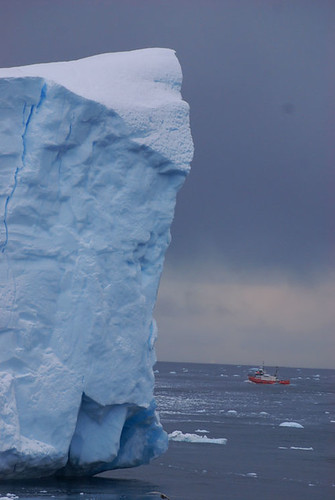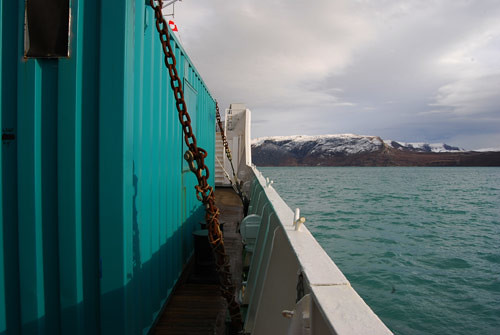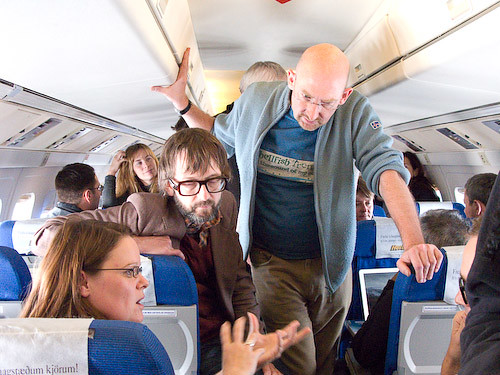We had a question come through from Birdie about the geology we are seeing up here, and so I thought I’d write a little about the history of the area, and in the process try to answer Birdie’s question! So here goes with the rocks……
Continue reading
Sorry I haven’t been blogging for a couple of days, but events and activities got the better of me! I was convinced we were on Wednesday today and was shocked that it is actually Friday! Somehow the Arctic induces a complete loss of any realisation of time, date and day.

Ice cave at Sermeq Avangnardleq. Photo: Carol Cotterill
On Tuesday evening (30th September) we ran a profile past the mouth of the Torssukatak fjord, into which two large glaciers feed, and up into the Suvdlorssuaq passage which runs between Disko Island and the Nugssuaq Peninsula. We have clearly imaged what I think are the lateral moraines for an old ice stream, standing proud of the seabed. There are also multiple channel incisions with sediment infilling.
Continue reading
Carol Cotterill and Dave Smith deploy the sparker, which uses acoustic pulses to image the sea bed and sediments below the sea bed. Video: Matt Wainwright.
Olga’s question
Will you comment on this survey? It were interesting. And what’s about the Grigoriy Mikheev. Is it a Russian vessel?
Carol Cotterill’s response
Dear Olga,
Firstly I’m so glad you’re reading the blogs on the Cape Farewell website! So in answer to your questions – yes the Grigory Mikheev is a Russian ship. She used to be a Russian research vessel and has now been converted to accommodate tourists. The crew are Russian, and the staff looking after us onboard are multi-national – Russian, English, Austrian and Belgian.
Continue reading
The day started with a walk to the viewpoint for the Jakobshavn Isbrae ice fjord – approximately 15km of the largest icebergs I have ever seen, grounded against a terminal moraine complex. Frustratingly the weather closed in and it started snowing with a vengeance. Whilst it looked lovely, the snow storm and accompanying gloom masked the iceberg calving events that were tantalisingly audible through the murk!
Continue reading

Ilulissat Kangia (Danish name Jacobshavn Glacier)
Continue reading

Photo by Nathan Gallagher
Success! We started the day with a sail up to the Jakobshavn Isbrae ice field, created by the grounding of icebergs from the glacier against a recessional moraine.
The glacier itself “flows” approximately 38m per day. However it only calves every 2 – 3 weeks according to local knowledge. This combination – fast flow rates and long periods between calving events results in very large bergs being discharged – see some of the attached photos!
Continue reading

Frustration reigns amongst the scientific staff at the moment. Initial problems with the triggering of the source were sorted yesterday afternoon. However we then discovered that the ship is a very noisy one acoustically speaking! Whilst the equipment was behaving perfectly, any return signal was being masked by the ship’s engines. Various options were discussed and tried, in liaison with the ship’s captain and crew, but at 11pm local time we decided to call it a night and start again in the morning.
Continue reading
Carol explains the kit she’ll be using during the voyage – the sparker unit – which uses acoustic pulses to image the sea bed and sediments below the sea bed. The ship’s acoustics leads to some initial frustration, followed by success!

The good news on reaching the Grigory Mikheev, our home for the next 10 days, was that it was the BGS container that made it on-board, and not one full of toothbrushes (my recurring nightmare of the past week or so), and it was dry inside and not flooded (Dave Smith’s recurring nightmare of the past week!) The bad news is that as we steam up the fjord from Kangerlussuaq, western Greenland, there is a Force 6 south-westerly waiting for us at the mouth of the fjord – 4 hours and counting until we start rolling around! I’m starting to spot a theme here after last year’s “rough seas” Cape Farewell Expedition across the Greenland Sea!
Continue reading

Well after an eventful trip out here including radar problems at London delaying our flight by 4 hours leaving us with 2 minutes to spare before Heathrow stopped all outgoing flights for the night (bit of a close shave that one), and luggage chaos as 43 people and 1500kgs of kit descended on 3 airports in 24 hours, we’ve made it! Whilst on the small plane from Iceland to Greenland, numerous photographs were taken of the eastern Greenland coast moving up over the icecap itself.
The fantastic aerial views of the glaciers feeding down from the icecap provoked a multitude of questions about glacier behaviour, stress and strain distributions and icecap thickness and age. A quiet discussion with a few people about the above questions soon resulted in filming and recording by both the American film crew and Quentin Cooper from Radio 4.
Continue reading
Well….our forthcoming trip to western Greenland suddenly seems to be looming very quickly following the official launch at the Science Museum on Tuesday evening (16th)! Kindly hosted by Chris Rapley, Director of the Science Museum, Cape Farewell descended onto the IMAX Cinema with an assortment of artists, musicians and scientists.
Continue reading









